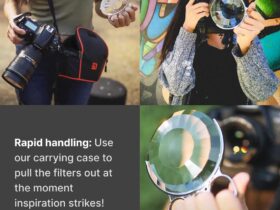To use a camera as a texture in Depence, configure the camera settings and apply it to a material. This process allows real-time video feed integration.
Using a camera as a texture in Depence can enhance your visual projects significantly. This feature enables the integration of real-time video feeds directly into your 3D scenes. It offers a dynamic and interactive element, making your renderings more engaging.
Configuring the camera settings properly is crucial for optimal performance. Adjust the resolution, frame rate, and other parameters to suit your needs. Applying the camera feed to a material involves selecting the appropriate options in the software. This technique is ideal for simulations, live events, and interactive displays. It provides a more immersive experience for viewers, elevating the overall quality of your project.

Introduction To Camera Textures
Camera textures bring a new dimension to digital design. They allow you to use live camera feeds as dynamic textures in your projects. This technique is becoming a popular choice among designers. Let’s dive into why camera textures are essential and their benefits.
Why Camera Textures?
Camera textures provide real-time interaction. This makes your designs more engaging. They capture live data from a camera feed. This data can then be applied as a texture on 3D models or surfaces. This method creates a more immersive experience.
Using camera textures can make your project stand out. They allow for unique, live elements in your design. This can be especially useful in interactive installations or live events. It offers a new way to connect with your audience.
Benefits Of Using Camera Textures
There are several benefits to using camera textures. Here are some key points:
- Real-Time Interaction: Camera textures provide live updates, making your design dynamic.
- Enhanced Engagement: They captivate your audience with real-time elements.
- Versatility: You can apply them to various surfaces and models.
- Innovation: They offer a fresh approach to digital design.
Below is a table summarizing the benefits:
| Benefit | Description |
|---|---|
| Real-Time Interaction | Live updates make designs dynamic. |
| Enhanced Engagement | Captivate your audience with live elements. |
| Versatility | Applicable to various surfaces and models. |
| Innovation | Offers a fresh approach to design. |
Camera textures can transform your projects. They add a unique, dynamic element. Start using camera textures in your designs today. It will make your work more engaging and innovative.
Setting Up Your Camera
Using your camera as a texture in Depence can enhance your project. Proper setup is crucial for the best results.
Choosing The Right Camera
Not all cameras are created equal. Some are better suited for texturing.
- DSLR Cameras: High resolution and versatile settings.
- Mirrorless Cameras: Lightweight and high-quality images.
- Smartphone Cameras: Convenient but may lack detail.
| Camera Type | Advantages | Disadvantages |
|---|---|---|
| DSLR | High resolution, manual settings | Bulky, expensive |
| Mirrorless | Lightweight, high quality | Battery life, cost |
| Smartphone | Convenient, portable | Lower detail, limited settings |
Configuring Camera Settings
Proper settings ensure the best quality for textures.
- Resolution: Set to the highest possible.
- ISO: Keep ISO low to avoid noise.
- Aperture: Use a small aperture for sharpness.
- White Balance: Adjust to match the lighting.
Double-check your settings before capturing your texture.
Capturing High-quality Textures
Capturing high-quality textures can transform your designs. Using a camera, you can create stunning textures. Follow these tips to achieve the best results.
Lighting Techniques
Good lighting is crucial for capturing textures. Natural light works best. Avoid direct sunlight as it creates harsh shadows.
Use diffused light for soft, even illumination. A cloudy day is perfect for this. If shooting indoors, use a lightbox or softbox.
Experiment with different light sources. Use lamps, LED panels, or even your phone flashlight. The goal is to avoid harsh shadows and highlight the texture’s details.
Optimal Angles For Textures
The angle of your camera affects the texture’s appearance. Shoot from various angles to find the best one.
Top-down angles capture flat textures well. This is great for surfaces like paper, fabric, and sand.
Side angles emphasize depth and details. Perfect for rough surfaces like bark, bricks, or stone.
Experiment with macro shots. Close-up photos reveal intricate details. Use a macro lens or the macro mode on your camera.
| Lighting Technique | Effect |
|---|---|
| Natural Light | Soft, even illumination |
| Diffused Light | Reduces harsh shadows |
| Side Lighting | Emphasizes texture depth |
- Use natural, diffused light.
- Experiment with various light sources.
- Try different camera angles.
- Use macro shots for details.
- Set up your lighting.
- Choose the right angle.
- Capture multiple shots.
- Review and select the best texture.

Editing Camera Textures
Editing camera textures can enhance your digital projects. The right techniques improve visual quality. This section covers basic and advanced editing tips.
Basic Editing Tips
Start with adjusting the brightness and contrast. Use simple tools to fine-tune these settings.
- Increase brightness for a lighter image
- Adjust contrast for better detail
Next, crop the texture to remove unwanted areas. This focuses on the main subject. Cropping also optimizes the texture for your project.
Use the resize tool to change the texture’s dimensions. This ensures it fits well in your design.
| Tool | Function |
|---|---|
| Brightness | Lighten the image |
| Contrast | Enhance details |
| Crop | Remove unwanted parts |
| Resize | Change dimensions |
Advanced Editing Techniques
Use layer blending to mix multiple textures. This adds depth and complexity to your design.
- Import textures into your editing software
- Place each texture on a separate layer
- Apply blending modes like Multiply or Overlay
Apply filters to achieve unique effects. Experiment with options such as Gaussian Blur or Sharpen.
Use color correction to match the texture to your project’s color scheme. Adjust hues, saturation, and lightness for better harmony.
For precise adjustments, use masking techniques. This allows you to edit specific areas without affecting the whole texture.
Finally, save your edited texture in a high-quality format. Common formats include PNG and JPEG.
# Example of saving an edited texture in Python:
from PIL import Image
texture = Image.open('edited_texture.png')
texture.save('final_texture.png', 'PNG')
Integrating Textures Into Designs
Textures give designs depth and realism. They make digital creations more lifelike. Using your camera as a texture source can be very effective. This method offers unique and personalized textures. Let’s explore how to integrate these textures into your designs.
Software Compatibility
To use camera textures, you need compatible software. Depence is one such software. It supports various texture formats. Check if your software supports image imports. Most design software accepts JPEG, PNG, and TIFF formats.
Importing Textures
Importing textures is simple. Follow these steps for seamless integration:
- Capture a photo using your camera.
- Save the image in a supported format.
- Open your design software.
- Navigate to the texture import section.
- Select the saved image file.
- Apply the texture to your design.
Software Compatibility
Ensure your design software supports various image formats. Here is a table of common formats:
| Format | Description |
|---|---|
| JPEG | Common format, good for photos. |
| PNG | Supports transparency, high quality. |
| TIFF | High quality, large file size. |
Importing Textures
After importing, you can edit textures. Crop, rotate, and resize them. Add filters or effects to enhance them. Use these textures in various design elements.
Enhancing Realism In Visuals
Using a camera as a texture can greatly enhance realism in visuals. It adds depth and authenticity to digital creations. This method captures real-world nuances, making digital scenes more lifelike.
Blending Textures
Blending textures is crucial for a seamless look. Combining different textures can create more complex and realistic visuals. For instance, a rough texture can be blended with a smooth one. This technique helps in mimicking real-world surfaces.
Here is a simple example:
| Texture Type | Blending Technique |
|---|---|
| Wood | Overlay with grain |
| Metal | Blend with rust |
Matching Colors And Tones
Matching colors and tones ensures visual consistency. The colors captured by the camera should match the scene. This helps in creating a unified look. Adjusting tones also enhances the overall aesthetic.
Here are a few tips:
- Use color correction tools.
- Adjust brightness and contrast.
- Match the lighting of the scene.
These steps help in achieving a realistic and harmonious visual output. Always ensure your textures and colors are well-aligned.
Creating Dynamic Backgrounds
Creating dynamic backgrounds using the camera as a texture opens new creative avenues. This technique involves capturing real-world visuals and applying them to 3D models. The result is a more immersive and realistic scene. Let’s explore some methods to achieve this.
Layering Techniques
Layering techniques add depth and complexity to your backgrounds. You can stack multiple textures to create a rich, detailed scene. Use different layers for different elements. For instance, have one layer for the sky and another for the ground. This way, each element can move independently. This creates a more dynamic effect.
- Base Layer: Start with a base layer that sets the scene.
- Detail Layers: Add layers for details like trees or buildings.
- Top Layer: Use the top layer for elements in the foreground.
Using Depth And Perspective
Depth and perspective make your backgrounds more engaging. These techniques create a sense of three-dimensional space. Position your camera at different angles to capture varied perspectives. This adds realism to your textures.
Use depth maps to further enhance the effect. A depth map is a grayscale image showing distance information. It helps to simulate how light interacts with objects at different distances.
- Capture Depth: Use a camera to capture depth information.
- Apply Depth Map: Apply the depth map to your texture.
- Adjust Light: Adjust lighting based on the depth map.
Incorporate these methods to create dynamic and engaging backgrounds. This will elevate your projects to the next level.
Texture Mapping In 3d Models
Texture mapping is a crucial part of 3D modeling. It gives objects a realistic look. This technique involves wrapping a 2D image around a 3D model. It brings surfaces to life with color and detail.
Basics Of Texture Mapping
The basics of texture mapping start with understanding UV coordinates. UV coordinates are a 2D representation of the 3D model’s surface.
- U represents the horizontal axis.
- V represents the vertical axis.
These coordinates help map the texture image onto the 3D model. Think of it like wrapping a gift. The paper is the texture, and the box is the 3D model. The goal is to cover the entire surface smoothly.
Advanced Mapping Techniques
Advanced techniques enhance the texture mapping process. These include:
- Normal Mapping
- Specular Mapping
- Displacement Mapping
Normal Mapping adds depth and detail to the surface without extra polygons. It uses a special texture that simulates small bumps and dents.
Specular Mapping controls the shininess of the surface. It highlights areas that should reflect light, making them look glossy or matte.
Displacement Mapping physically alters the mesh of the model. It creates real bumps and grooves, adding a high level of detail.
| Technique | Description |
|---|---|
| Normal Mapping | Adds depth and detail without extra polygons. |
| Specular Mapping | Controls surface shininess and reflections. |
| Displacement Mapping | Physically alters the model’s mesh for real bumps. |
Using these techniques, artists can create more realistic models. They enhance the visual appeal and complexity of 3D objects.
Using Textures In Digital Art
Textures can transform digital art from flat and boring to dynamic and engaging. By using textures, artists can add depth, realism, and interest to their creations. Textures can come from a variety of sources, including photographs, scanned images, or digital brushes. One popular technique is to use a camera as a texture source. This method allows artists to capture unique, real-world textures and incorporate them directly into their digital work.
Creating Texture Brushes
Texture brushes are essential tools for digital artists. They allow for quick and consistent application of textures. Here’s how to create your own texture brushes:
- Capture a texture: Use your camera to take a photo of an interesting texture.
- Edit the image: Use software to adjust brightness, contrast, and remove any unwanted elements.
- Convert to brush: Import the image into your art software and define it as a brush.
Using texture brushes can save time and ensure consistent results across different projects. Experiment with different settings to achieve the desired effect.
Incorporating Textures
Incorporating textures into your digital art can be done in several ways:
- Overlay: Place the texture layer above your artwork and adjust the blend mode.
- Masking: Use layer masks to apply textures to specific areas.
- Clipping masks: Clip a texture layer to a shape or object for precise application.
When incorporating textures, it’s important to consider how they interact with other elements in your composition. This can enhance the overall impact of your artwork.
Below is a table that summarizes some common techniques for incorporating textures:
| Technique | Description |
|---|---|
| Overlay | Apply texture on top of artwork and adjust blend mode. |
| Masking | Use layer masks to control where the texture appears. |
| Clipping masks | Clip texture to a shape for precise placement. |
By using textures effectively, digital artists can create more engaging and realistic artwork.
Textures For Web Design
Textures can make a website more engaging. They add depth and interest to a page. Using a camera as a texture source is unique. This technique brings real-world textures into digital design.
Web-friendly Formats
Choosing the right file format is crucial. JPEG and PNG are the most common. JPEG is great for photos and complex images. It offers a balance between quality and file size. PNG supports transparency and is ideal for simple graphics.
For high-resolution textures, consider WebP. It offers better compression. This format reduces file size without losing quality.
| Format | Best For | Advantages |
|---|---|---|
| JPEG | Photos | Good quality, small file size |
| PNG | Graphics with transparency | Supports transparency, lossless compression |
| WebP | High-resolution textures | Better compression, retains quality |
Optimizing Load Times
Fast load times are essential. Large texture files can slow down a site. Optimizing images reduces load times. Use tools like TinyPNG or ImageOptim to compress files.
Lazy loading can also help. This technique loads images only when needed. It reduces initial load time. Use the loading="lazy" attribute in your image tags.
- Compress images before uploading
- Use lazy loading for images
- Choose the right format for each image
These steps ensure your site remains fast and efficient. They improve user experience and SEO.
Textures In Motion Graphics
Textures play a crucial role in motion graphics. They add depth and realism to animations. Using cameras as textures in Depence can elevate your projects. This technique provides more dynamic and engaging visual effects.
Animating Textures
Animating textures involves moving the texture across the screen. This brings a static image to life. You can use keyframes to control the movement. Adjust the speed and direction for different effects. This adds a layer of complexity to your animations.
Consider the following methods to animate textures:
- Keyframe Animation: Set specific points in time for texture movement.
- Looping: Create a seamless loop for continuous motion.
- Random Motion: Add randomness to the texture’s path.
Seamless Transitions
Seamless transitions are vital in motion graphics. They ensure smooth changes between scenes. Using camera textures can help achieve this. By blending textures, transitions can be made more fluid.
Here are some techniques for seamless transitions:
- Fade In/Out: Gradually increase or decrease opacity.
- Motion Blur: Apply blur to soften the transition.
- Crossfade: Blend two textures together for a smooth effect.
Combining these techniques can enhance your motion graphics. Experiment with different settings to find the best results. Using camera textures in Depence makes this process easier and more creative.

Textural Storytelling
Textural storytelling breathes life into digital art. Using Depence’s camera as texture feature, artists can create rich, evocative scenes. This tool offers endless possibilities for crafting immersive environments.
Creating Mood With Textures
Textures can set the tone of your scene. A grainy texture adds an eerie feel. Smooth textures can make the scene look clean and modern.
Using Depence’s camera as texture, you can capture real-world textures. This makes the digital scene more believable. For example, a photo of rough concrete can add grit to a scene.
| Texture Type | Effect |
|---|---|
| Grainy | Creates an eerie, unsettling mood |
| Smooth | Gives a clean, modern look |
| Rough | Adds a gritty, realistic feel |
Narrative Techniques
Textures can also tell a story. A weathered wall texture can hint at decay. A polished wood texture suggests care and maintenance.
Depence’s camera as texture helps capture these details. Artists can use textures to guide the viewer’s emotions. This makes the story more engaging and believable.
Here are some techniques for using textures in your narrative:
- Contrast: Use different textures to highlight important elements.
- Repetition: Repeating textures can create a sense of unity.
- Texture Mapping: Map textures to objects to add depth.
By mastering these techniques, you can make your digital art more compelling.
Common Challenges And Solutions
Using a camera as a texture in Depence can be tricky. Users often face various challenges. Knowing these common issues and their solutions can save time.
Avoiding Texture Overload
Too many textures can slow down your system. This can make your project laggy and hard to work with. To avoid this, use textures wisely.
- Limit the number of textures used.
- Use low-resolution textures where possible.
- Optimize textures before importing them into Depence.
By following these steps, you can avoid texture overload. This keeps your project running smoothly.
Fixing Distorted Textures
Distorted textures can ruin your visuals. They often appear stretched or skewed. Fixing this is essential for a professional look.
- Check the aspect ratio of your textures.
- Ensure the camera settings match the texture dimensions.
- Use UV mapping tools to adjust texture placement.
Using these methods can fix most distortion issues. Your textures will look clean and accurate.
| Challenge | Solution |
|---|---|
| Texture Overload | Limit, Optimize, Use Low-Resolution |
| Distorted Textures | Aspect Ratio, Camera Settings, UV Mapping |
Understanding these challenges and solutions can improve your workflow. Your Depence projects will be more efficient and visually appealing.
Future Trends In Camera Textures
The future of camera textures is exciting. Innovative technologies are transforming how we see digital worlds. AI and VR/AR are key players in this evolution.
Ai And Textures
Artificial Intelligence (AI) is revolutionizing camera textures. AI can create hyper-realistic textures. This makes digital images look life-like.
AI algorithms analyze real-world images. They generate detailed textures from these analyses. This process is fast and efficient.
Here are some benefits of AI in textures:
- Enhanced image quality
- Reduced manual effort
- Faster texture generation
AI also helps in real-time texture updates. This is useful for dynamic environments.
Vr And Ar Applications
Virtual Reality (VR) and Augmented Reality (AR) are changing the game. They use camera textures to create immersive experiences.
In VR, textures make virtual worlds more believable. Detailed textures enhance the sense of presence.
AR overlays digital textures on the real world. This makes interactions more engaging.
Here are some applications of VR and AR:
- Gaming
- Education
- Healthcare
Future trends in camera textures will rely heavily on VR and AR. These technologies promise to deliver unprecedented experiences.
Frequently Asked Questions
What Camera Settings For Texture?
Use a low ISO (100-200) for minimal noise. Set a narrow aperture (f/8-f/16) for deeper depth of field. Use a tripod to avoid camera shake. Adjust shutter speed based on lighting. Use manual focus for sharp details.
How Do You Rotate The Camera In Depence?
To rotate the camera in Depence, hold the right mouse button and drag. Use the scroll wheel to zoom in and out.
What Is Using A Camera As Texture?
Using a camera as texture involves integrating live camera feeds as surface textures in 3D models.
How Do You Set Up A Camera Texture?
Set up a camera texture by linking the live camera feed to the 3D model’s texture map.
Why Use A Camera For Texture?
Using a camera for texture enhances realism by adding dynamic, real-time visuals.
Which Software Supports Camera As Texture?
Software like Blender, Unity, and Unreal Engine support camera textures.
Can I Use Any Camera For Textures?
Yes, most webcams and digital cameras can be used for textures.
What Are The Benefits Of Camera Textures?
Camera textures provide real-time updates, enhancing interactivity and realism.
Are Camera Textures Resource-intensive?
Yes, they can be resource-intensive, requiring powerful hardware for smooth performance.
How Do Camera Textures Improve 3d Models?
They add dynamic, real-time elements, making models more engaging and realistic.
Conclusion
Using a camera as a texture tool can transform your creative projects. It adds depth and uniqueness to any design. Experimenting with textures enhances visual appeal and engages audiences. Start incorporating camera textures today and elevate your artistic work to new heights.
Embrace this technique for stunning results.










Leave a Reply